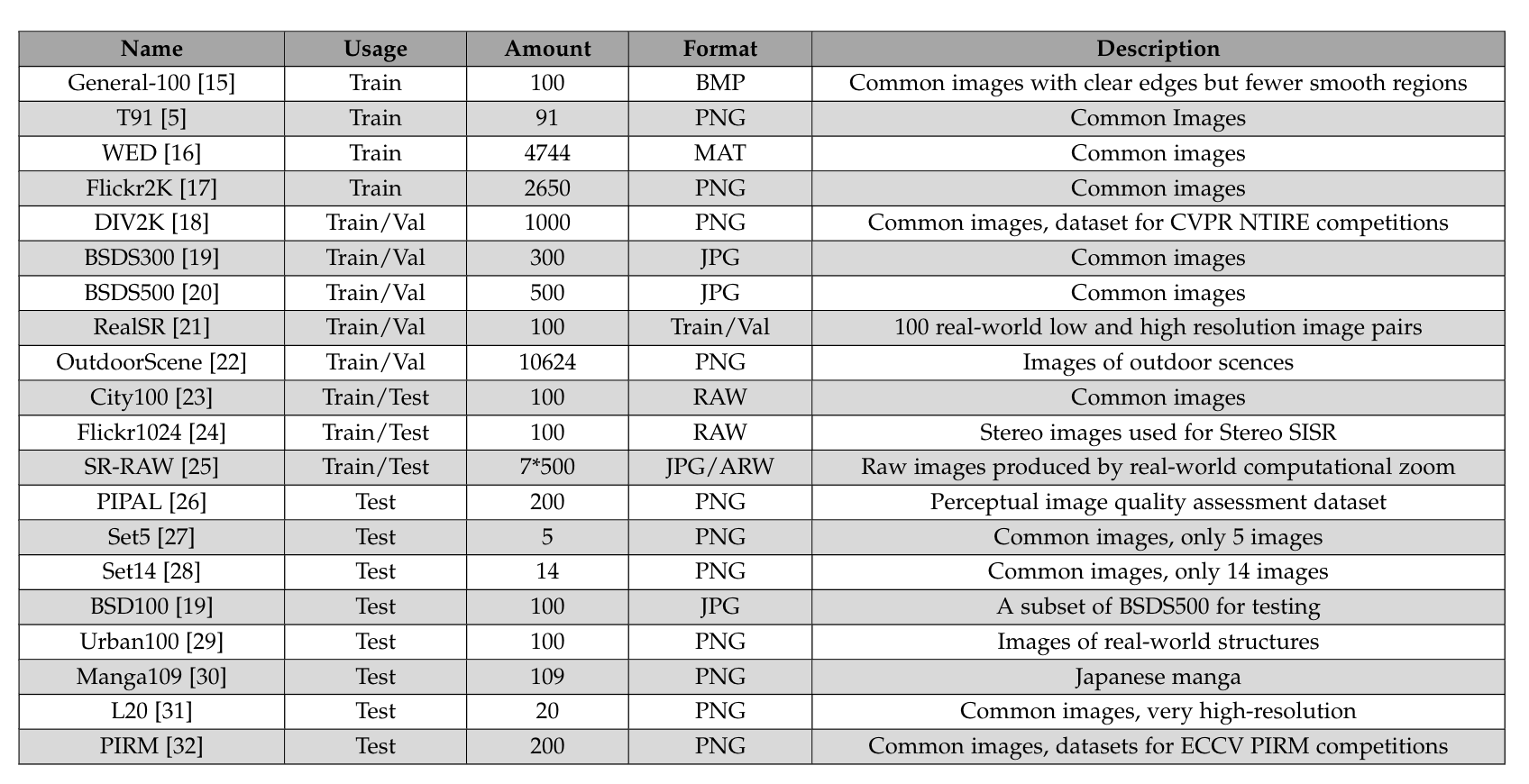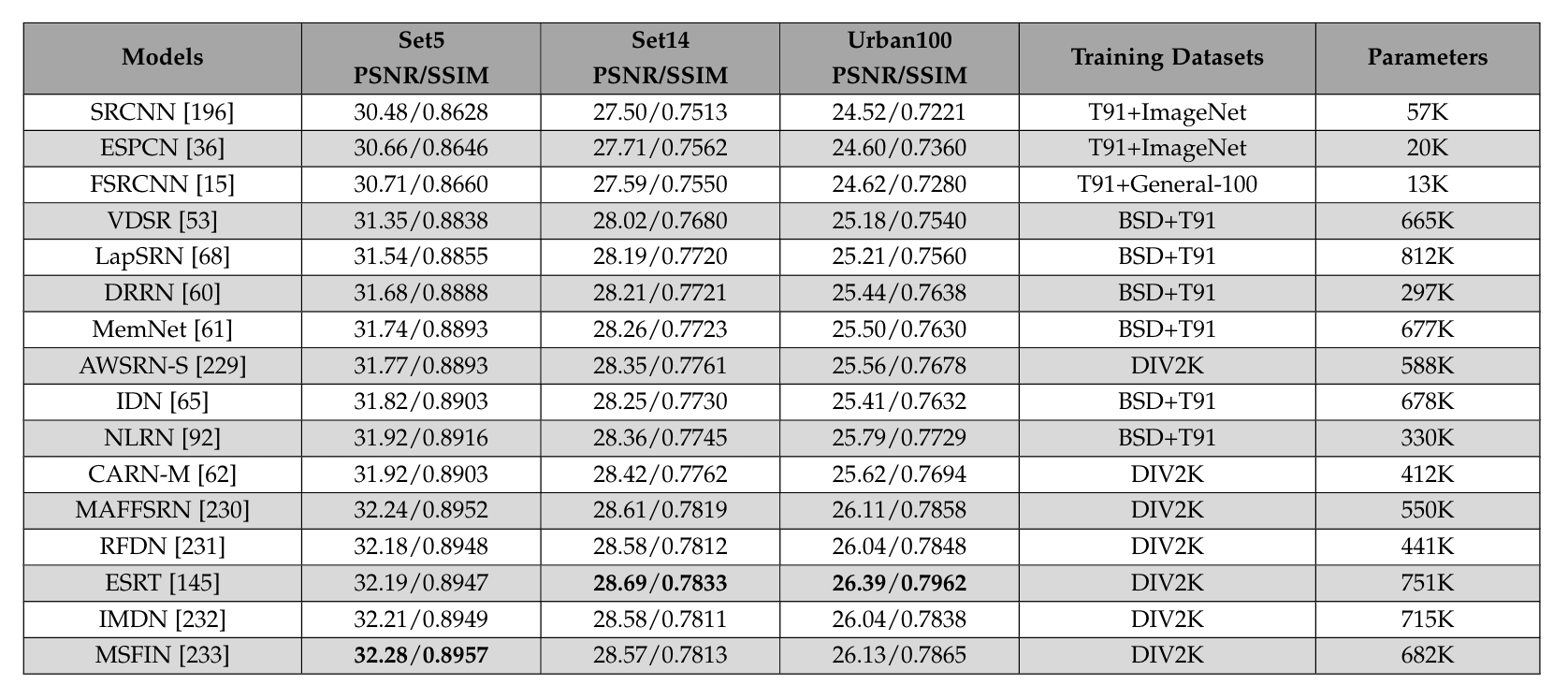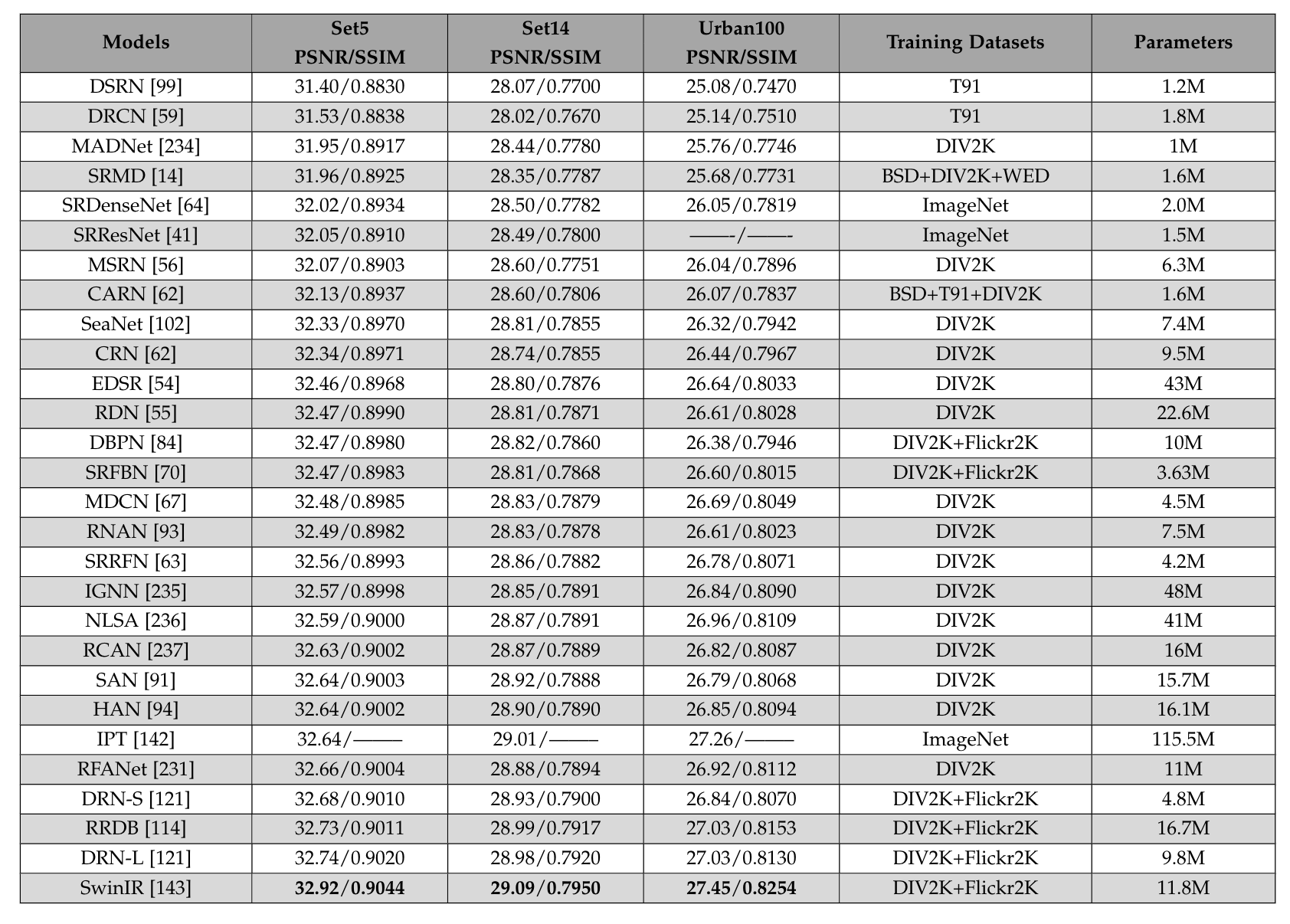SISR-Survey
An investigation project for SISR.
This repository is an official project of the paper "From Beginner to Master: A Survey for Deep Learning-based Single-Image Super-Resolution".
Purpose
Due to the pages and time limitation, it is impossible to introduce all SISR methods in the paper, and it is impossible to update the latest methods in time. Therefore, we use this project to assist our survey to cover more methods. This will be a continuously updated project! We hope it can help more researchers and promote the development of image super-resolution. Welcome more researchers to jointly maintain this project!
Abstract
Single-image super-resolution (SISR) is an important task in image processing, which aims to enhance the resolution of imaging systems. Recently, SISR has made a huge leap and has achieved promising results with the help of deep learning (DL). In this survey, we give an overview of DL-based SISR methods and group them according to their targets, such as reconstruction efficiency, reconstruction accuracy, and perceptual accuracy. Specifically, we first introduce the problem definition, research background, and the significance of SISR. Secondly, we introduce some related works, including benchmark datasets, upsampling methods, optimization objectives, and image quality assessment methods. Thirdly, we provide a detailed investigation of SISR and give some domain-specific applications of it. Fourthly, we present the reconstruction results of some classic SISR methods to intuitively know their performance. Finally, we discuss some issues that still exist in SISR and summarize some new trends and future directions. This is an exhaustive survey of SISR, which can help researchers better understand SISR and inspire more exciting research in this field.
Taxonomy
Datasets
Benchmarks datasets for single-image super-resolution (SISR).
SINGLE-IMAGE SUPER-RESOLUTION
Reconstruction Efficiency Methods
Perceptual Quality Methods
Perceptual Quality Methods
Further Improvement Methods
DOMAIN-SPECIFIC APPLICATIONS
Real-World SISR
Remote Sensing Image Super-Resolution
Hyperspectral Image Super-Resolution
In contrast to human eyes that can only be exposed to visible light, hyperspectral imaging is a technique for collecting and processing information across the entire range of electromagnetic spectrum. The hyperspectral system is often compromised due to the limitations of the amount of the incident energy, hence there is a trade-off between the spatial and spectral resolution. Therefore, hyperspectral image super-resolution is studied to solve this problem.
[1] Hyperspectral Image Spatial Super-Resolution via 3D Full Convolutional Neural Network
[2] Single Hyperspectral Image Super-Resolution with Grouped Deep Recursive Residual Network
[3] Hyperspectral Image Super-Resolution with Optimized RGB Guidance
[4] Learning Spatial-Spectral Prior for Super-Resolution of Hyperspectral Imagery
Light Field Image Super-Resolution
Light field (LF) camera is a camera that can capture information about the light field emanating from a scene and can provide multiple views of a scene. Recently, the LF image is becoming more and more important since it can be used for post-capture refocusing, depth sensing, and de-occlusion. However, LF cameras are faced with a trade-off between spatial and angular resolution. In order to solve this issue, SR technology is introduced to achieve a good balance between spatial and angular resolution.
[1] Light-field Image Super-Resolution Using Convolutional Neural Network
[3] Spatial-Angular Interaction for Light Field Image Super-Resolution
[4] Light Field Image Super-Resolution Using Deformable Convolution
Face Image Super-Resolution
Face image super-resolution is the most famous field in which apply SR technology to domain-specific images. Due to the potential applications in facial recognition systems such as security and surveillance, face image super-resolution has become an active area of research.
[1] Learning Face Hallucination in the Wild
[2] Deep Cascaded Bi-Network for Face Hallucination
[4] Super-Identity Convolutional Neural Network for Face Hallucination
[5] Exemplar Guided Face Image Super-Resolution without Facial Landmarks
[6] Robust Facial Image Super-Resolution by Kernel Locality-Constrained Coupled-Layer Regression
Medical Image Super-Resolution
Medical imaging methods such as computational tomography (CT) and magnetic resonance imaging (MRI) are essential to clinical diagnoses and surgery planning. Hence, high-resolution medical images are desirable to provide necessary visual information of the human body. Recently, many methods have been proposed for medical image super-resolution
[2] CT-Image of Rock Samples Super Resolution Using 3D Convolutional Neural Network
[3] Channel Splitting Network for Single MR Image Super-Resolution
[4] SAINT: Spatially Aware Interpolation Network for Medical Slice Synthesis
Depth Map Super-Resolution
The depth map is an image or image channel that contains information relating to the distance of the surfaces of scene objects from a viewpoint. The use of depth information of a scene is essential in many applications such as autonomous navigation, 3D reconstruction, human-computer interaction, and virtual reality. However, depth sensors, such as Microsoft Kinect and Lidar, can only provide depth maps of limited resolutions. Hence, depth map super-resolution has drawn more and more attention recently.
[1] Deep Depth Super-Resolution: Learning Depth Super-Resolution Using Deep Convolutional Neural Network
[2] Atgv-net: Accurate Depth Super-Resolution
[3] Depth Map Super-Resolution by Deep Multi-Scale Guidance
[4] Deeply Supervised Depth Map Super-Resolution as Novel View Synthesis
[5] Perceptual Deep Depth Super-Resolution
[6] Channel Attention based Iterative Residual Kearning for Depth Map Super-Resolution
Stereo Image Super-Resolution
The dual camera has been widely used to estimate depth information. Meanwhile, stereo imaging can also be applied in image restoration. In the stereo image pair, we have two images with disparity much larger than one pixel. Therefore, full use of these two images can enhance the spatial resolution.
[1] Enhancing the Spatial Resolution of Stereo Images Using A Parallax Prior
[2] Learning Parallax Attention for Stereo Image Super-Resolution
[3] Parallax Attention for Unsupervised Stereo Correspondence Learning
[4] Flickr1024: A Large-Scale Dataset for Stereo Image Super-Resolution
[5] A Stereo Attention Module for Stereo Image Super-Resolution
[6] Symmetric Parallax Attention for Stereo Image Super-Resolution
[7] Deep Bilateral Learning for Stereo Image Super-Resolution
[8] Stereoscopic Image Super-Resolution with Stereo Consistent Feature
[9] Feedback Network for Mutually Boosted Stereo Image Super-Resolution and Disparity Estimation
RECONSTRUCTION RESULTS
PSNR/SSIM comparison of lightweight SISR models (the number of model parameters less than 1000K) on Set5 (x4), Set14 (x4), and Urban100 (x4). Meanwhile, the training datasets and the number of model parameters are provided. Sort by PSNR of Set5 in ascending order. Best results are highlighted.
PSNR/SSIM comparison of large SISR models (the number of model parameters more than 1M, M=million) on Set5 (x4), Set14 (x4), and Urban100 (x4). Meanwhile, the training datasets and the number of model parameters are provided. Sort by PSNR of Set5 in ascending order. Best results are highlighted.




